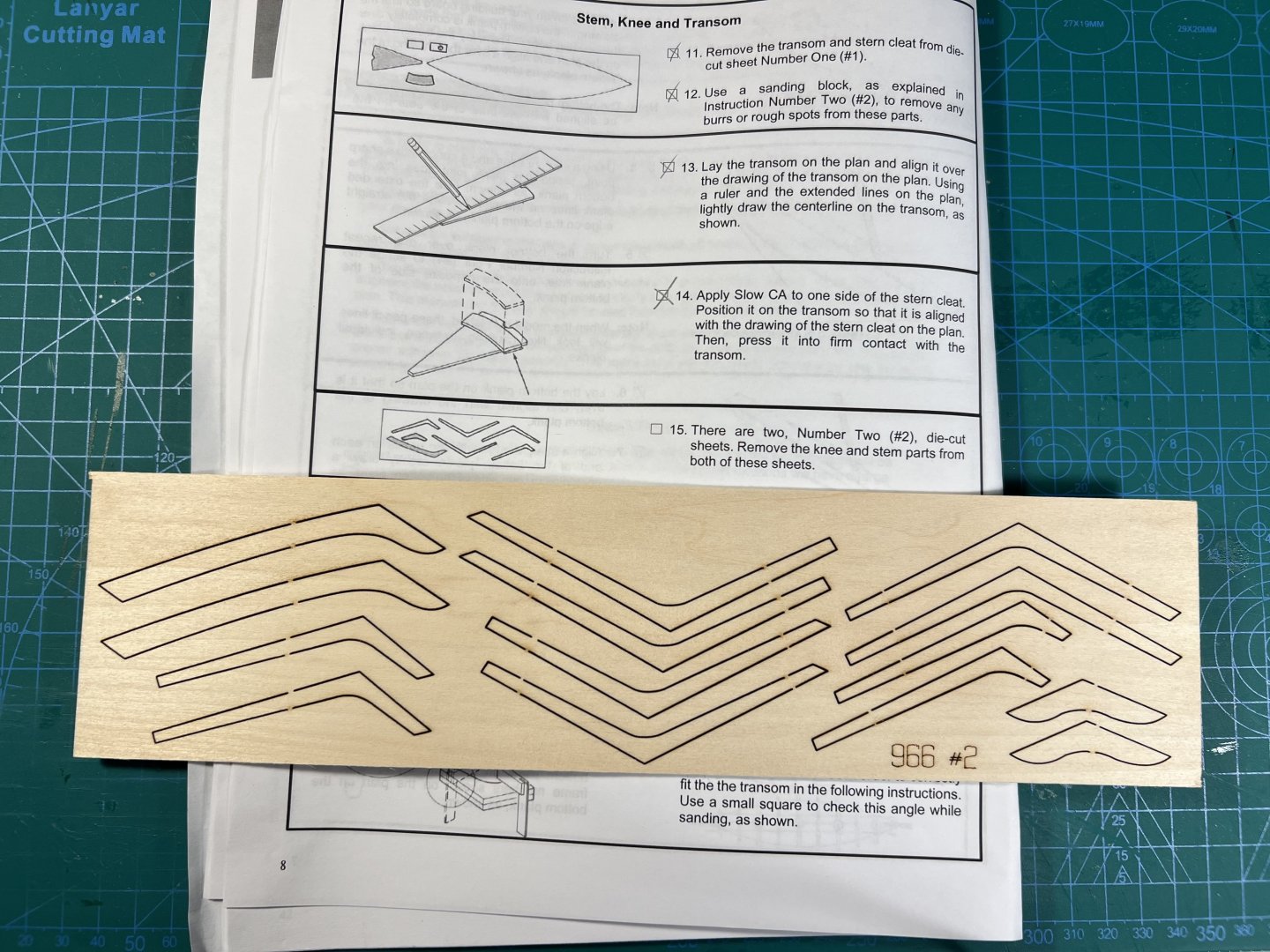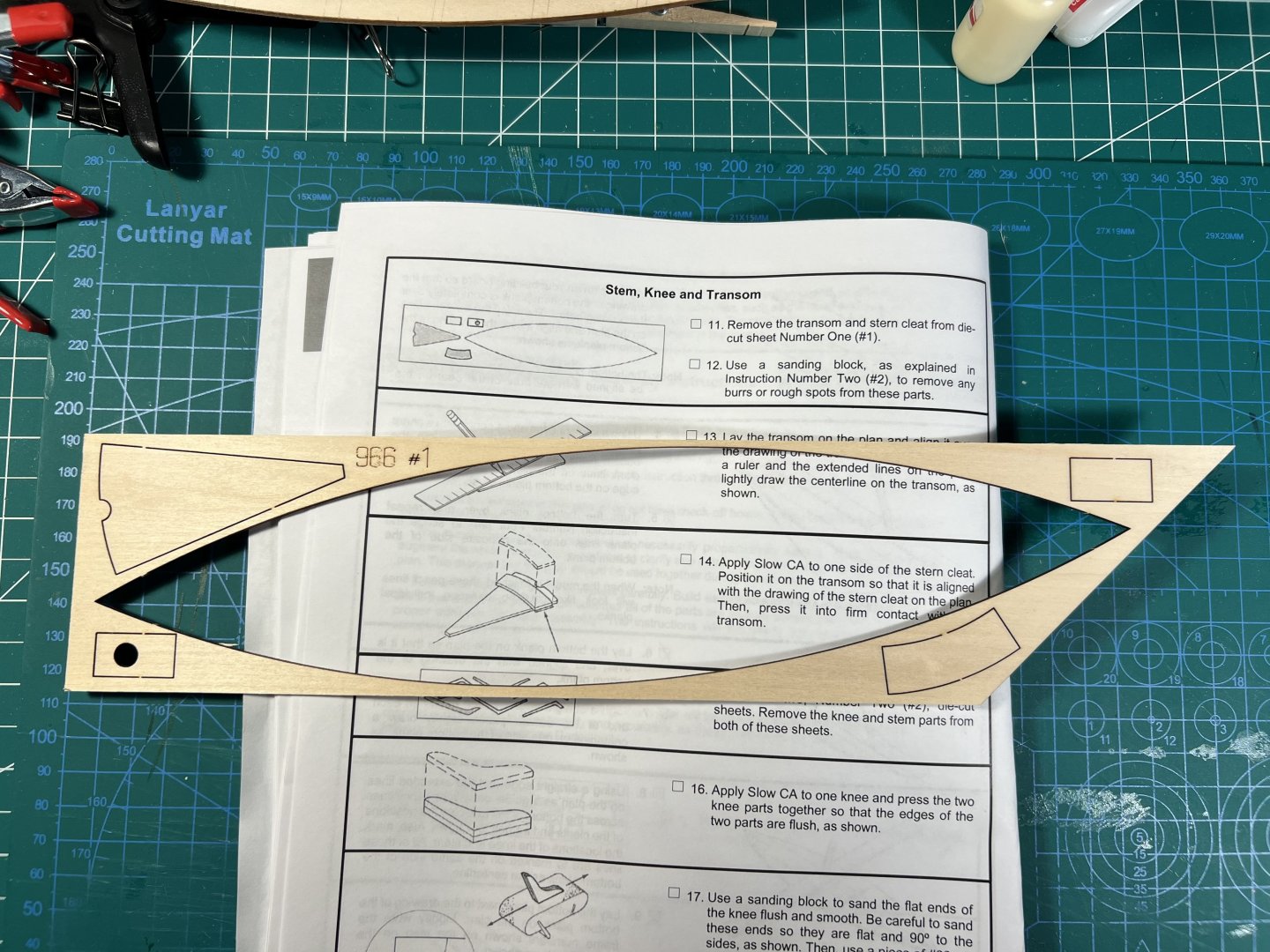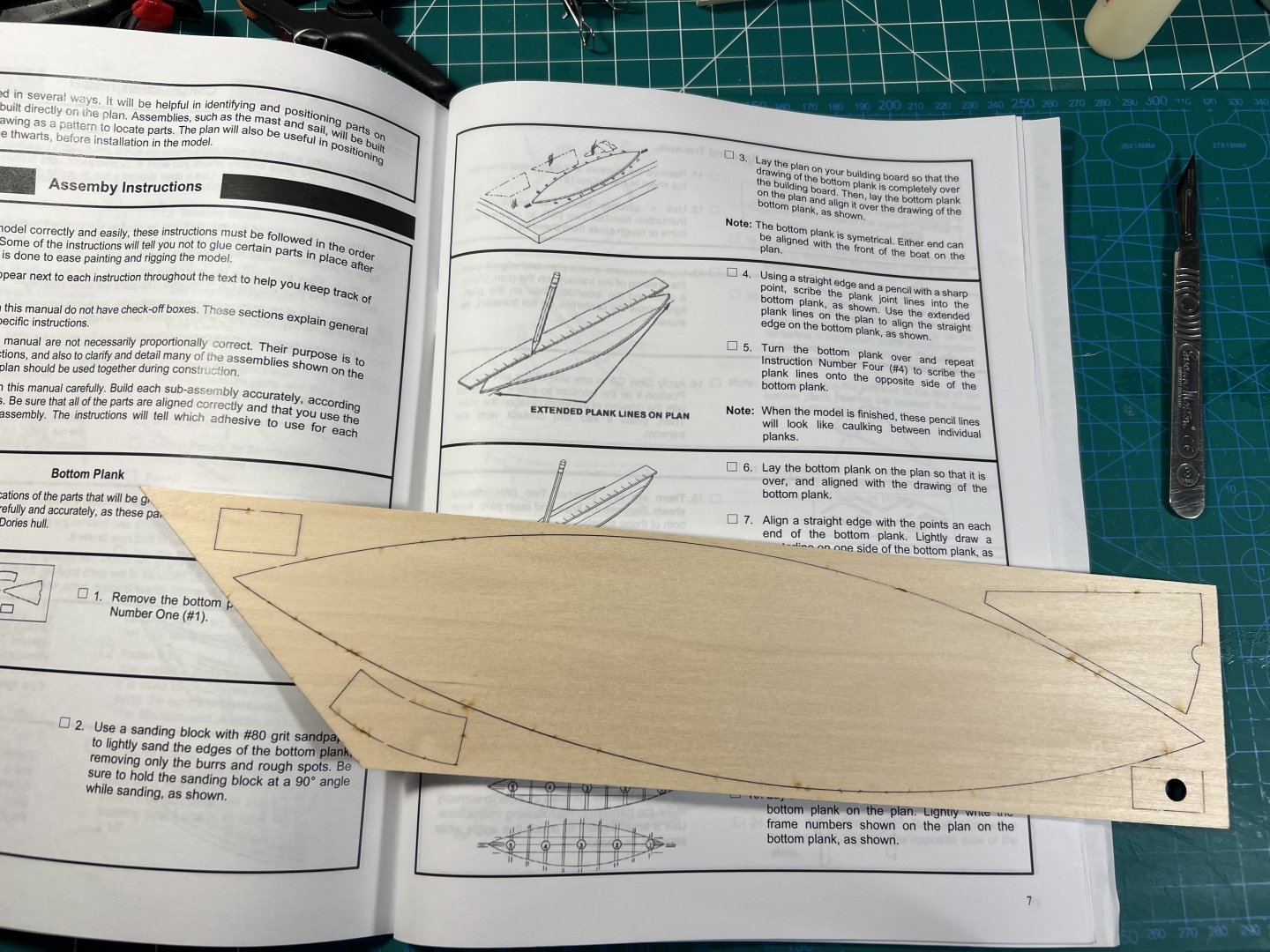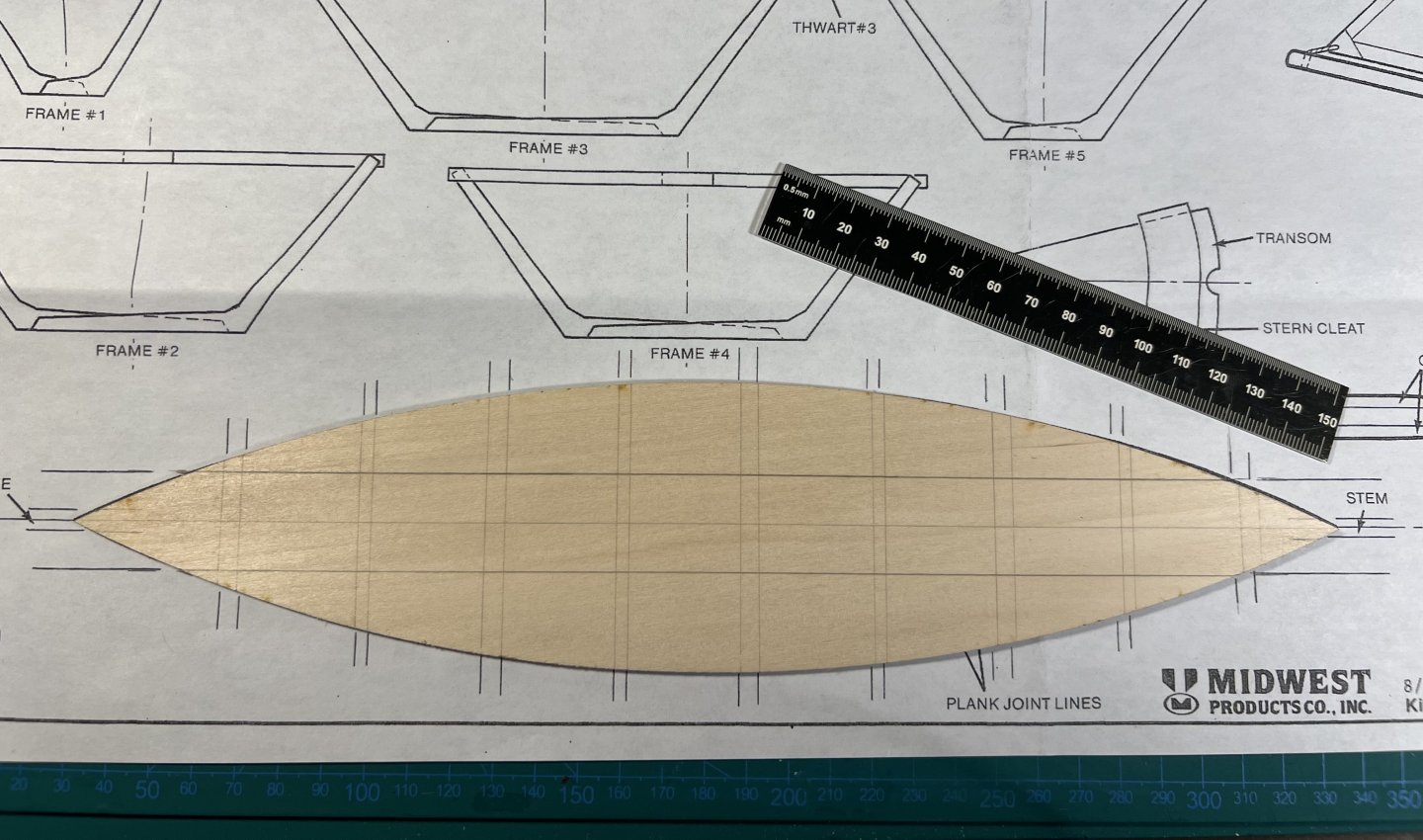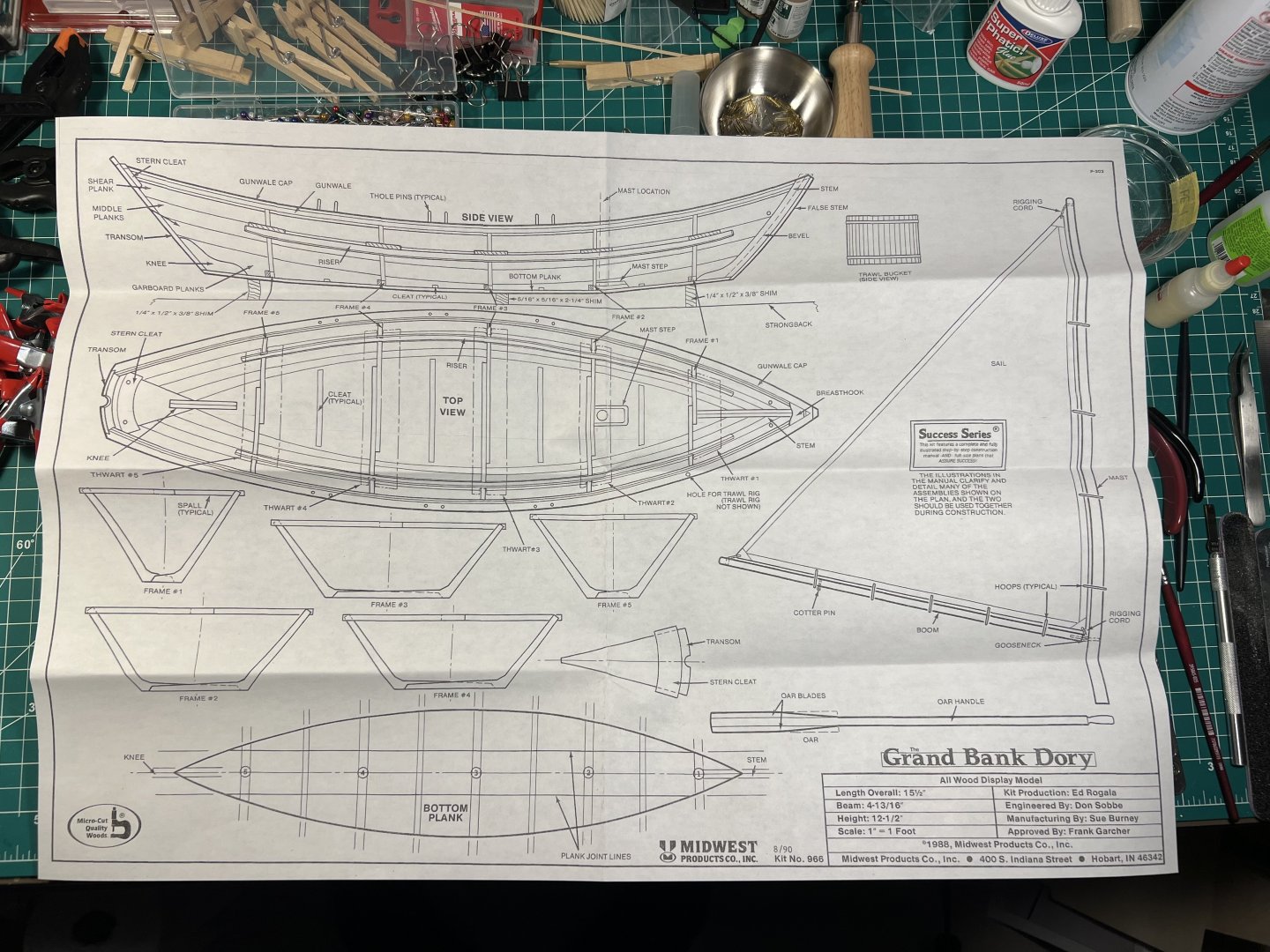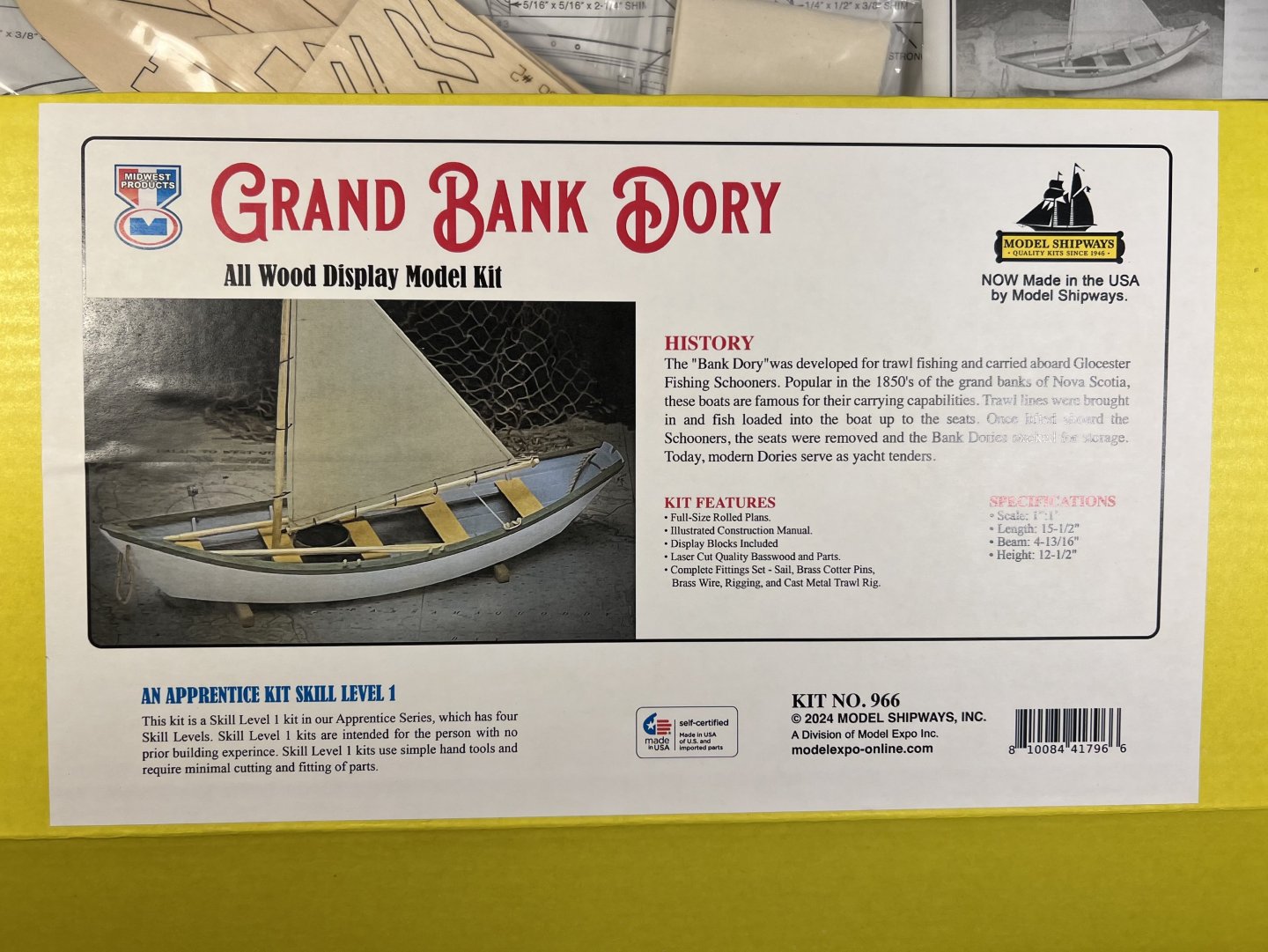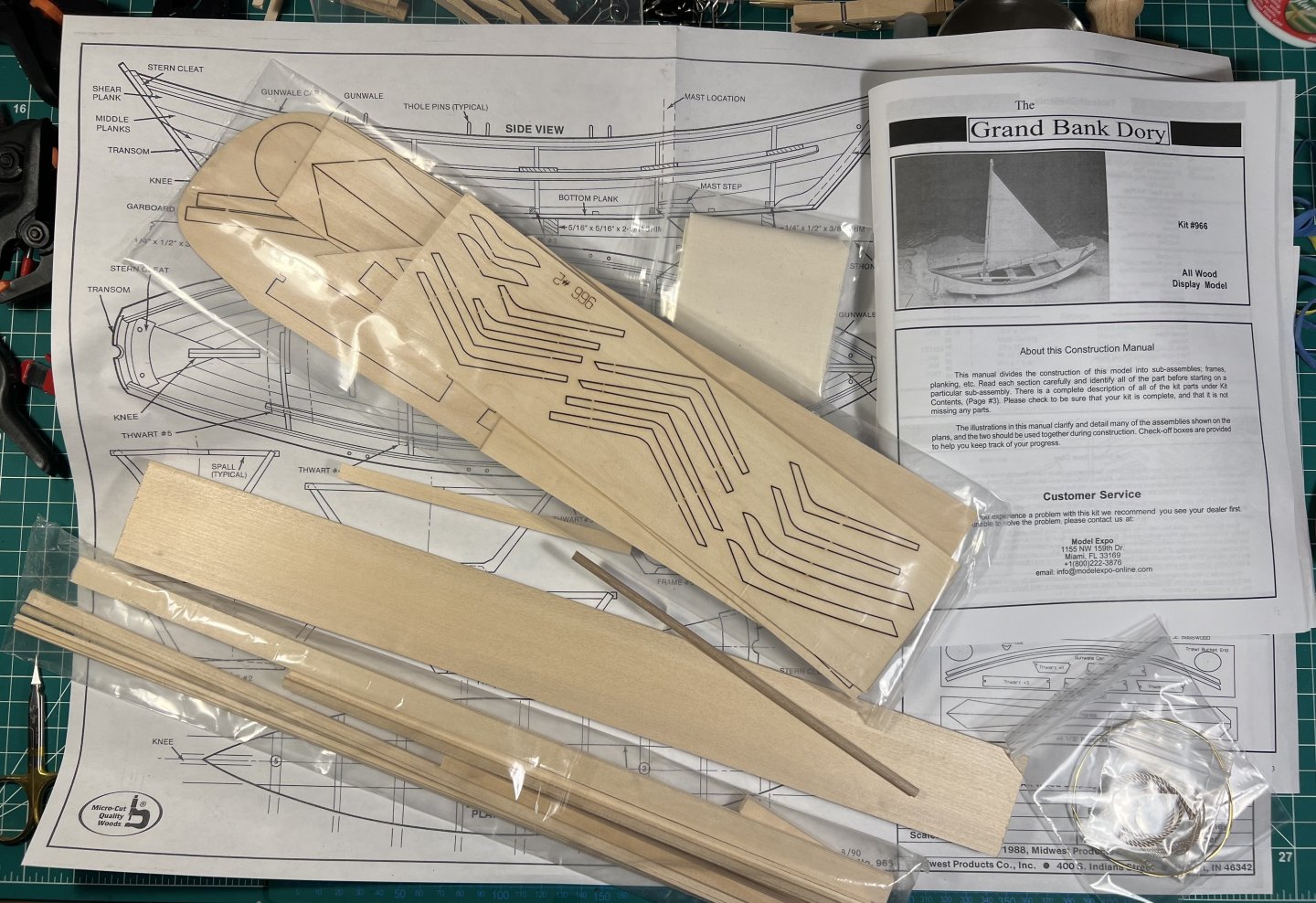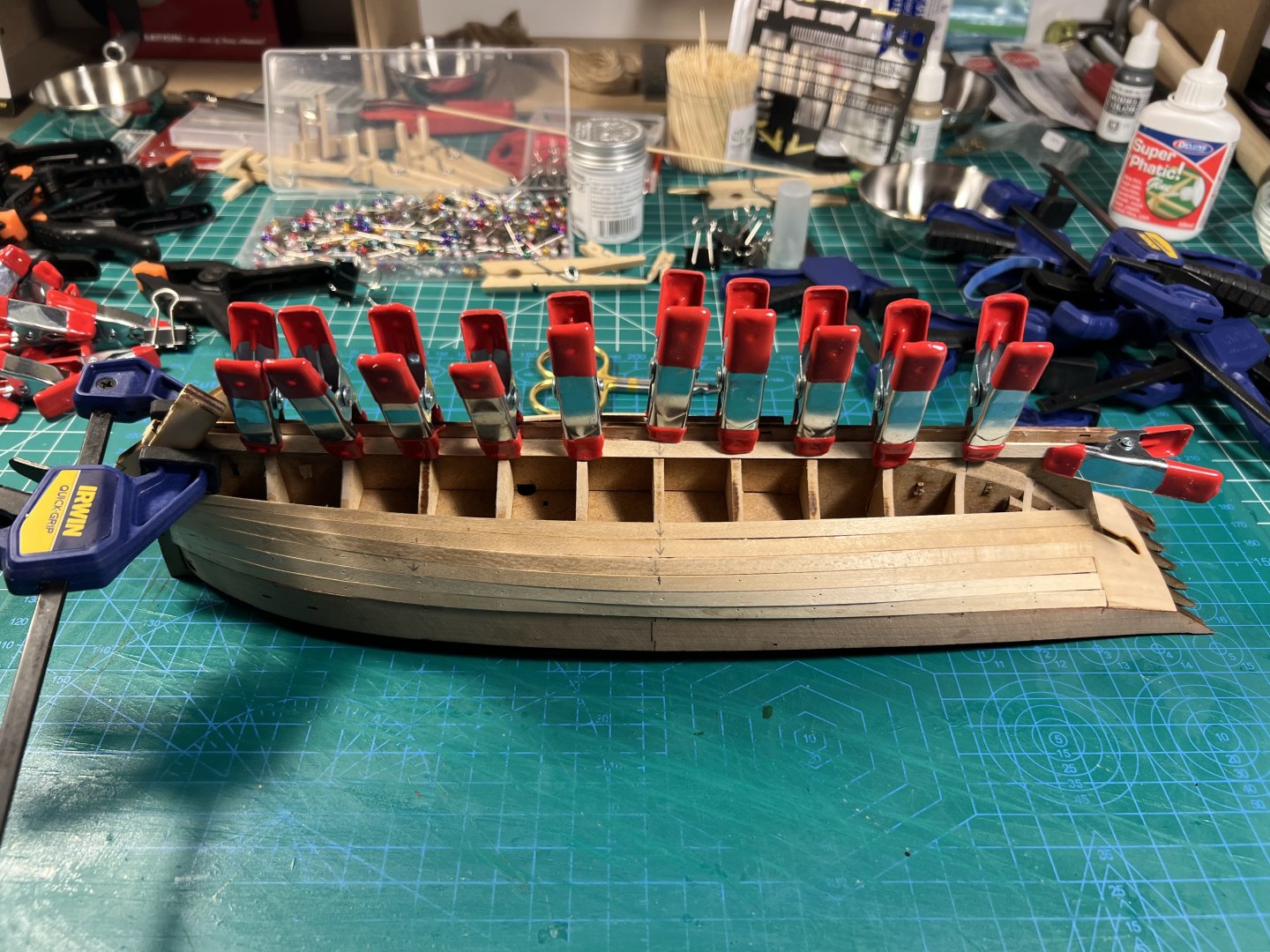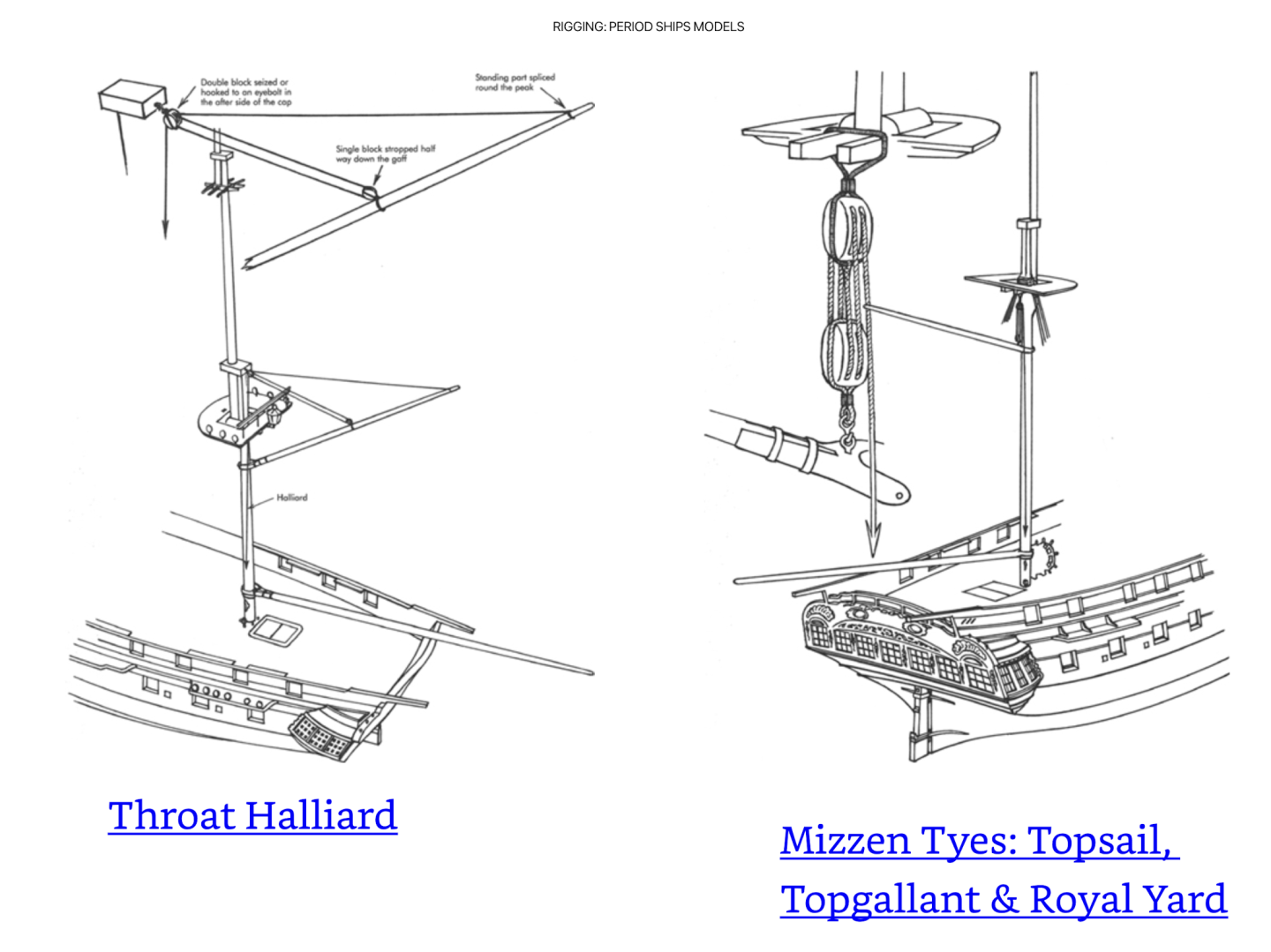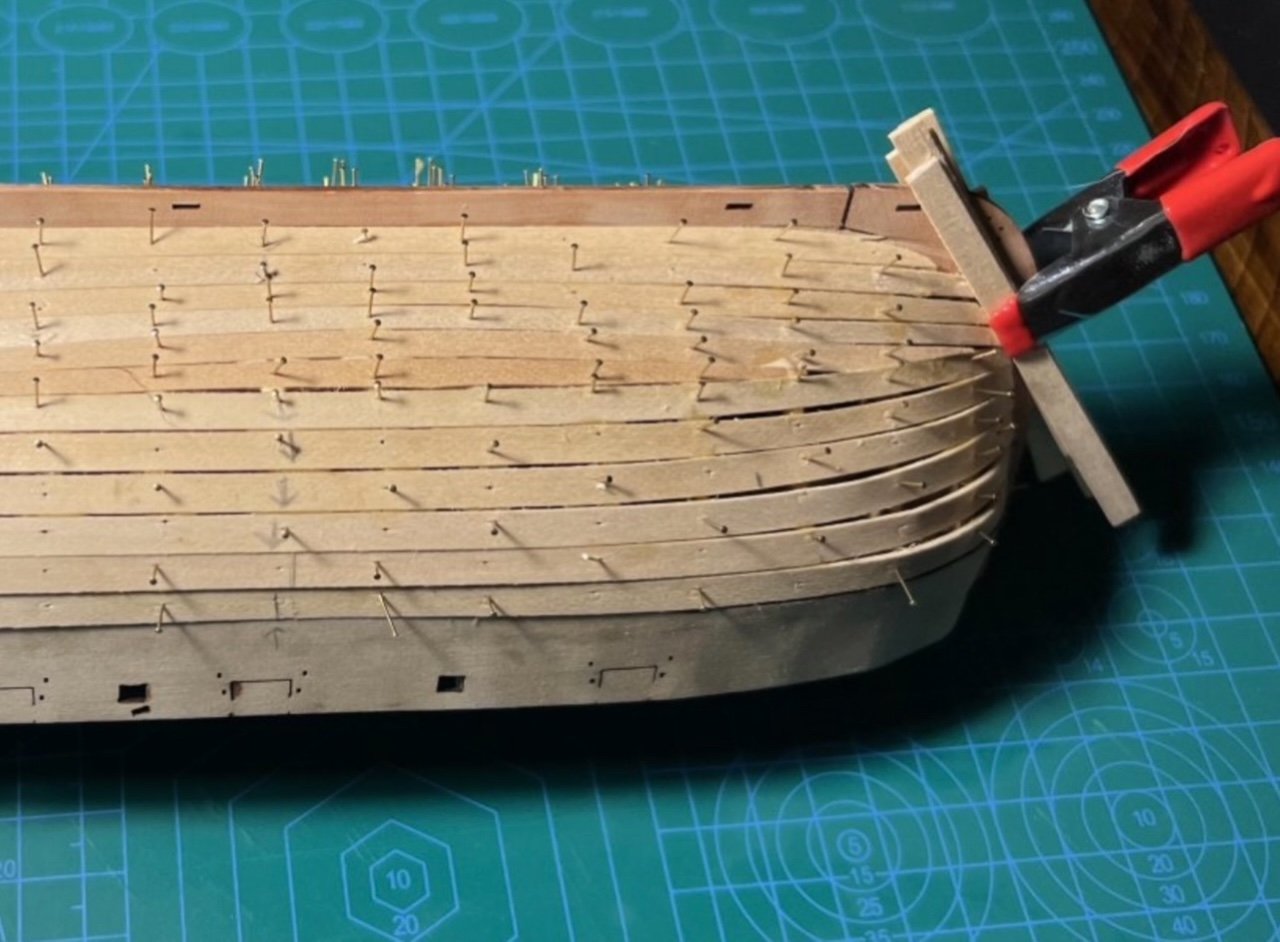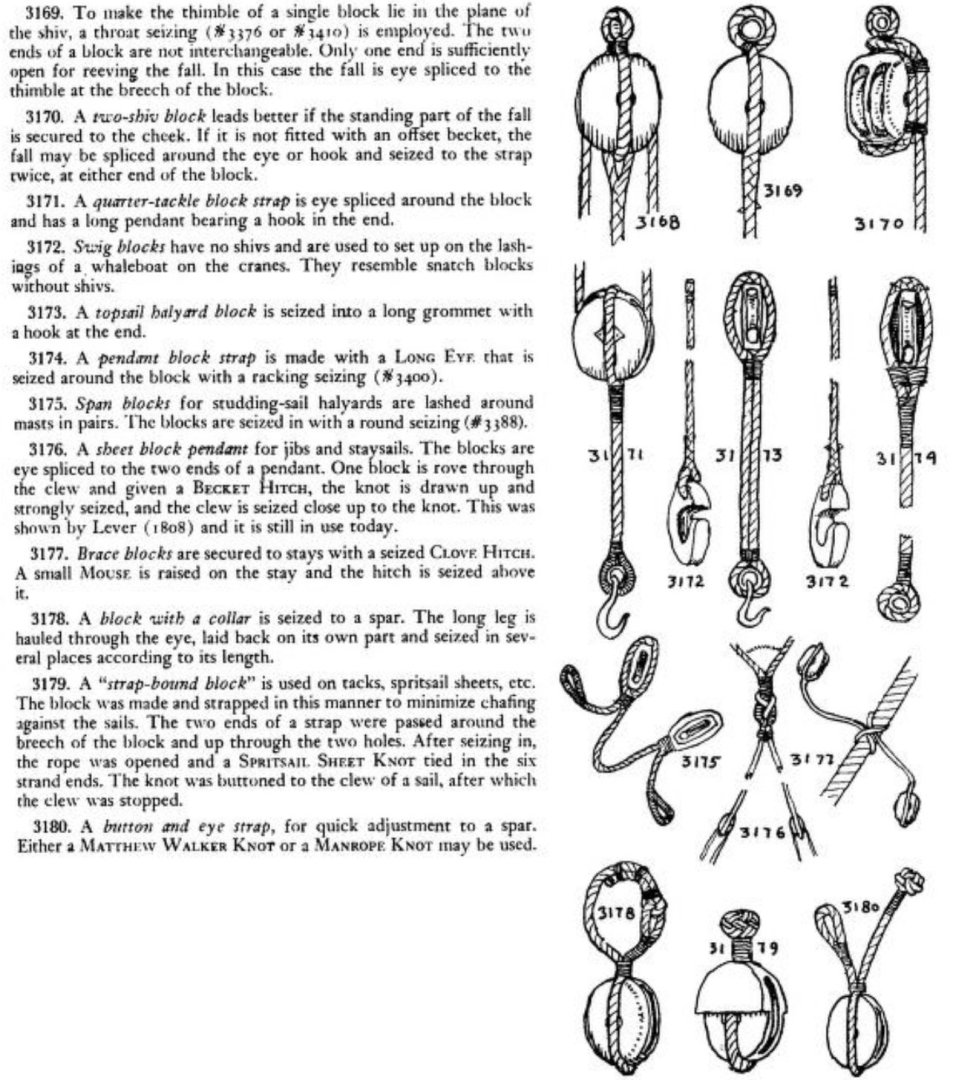
palmerit
NRG Member-
Posts
999 -
Joined
-
Last visited
Content Type
Profiles
Forums
Gallery
Events
Everything posted by palmerit
-
Instructions say “there are two, Number Two (#2), die-cut sheets”. There’s only one #2 with twice as many parts.
- 71 replies
-
- grand banks dory
- midwest products
-
(and 2 more)
Tagged with:
-
The instructions show the layout of sheet #1 and shade in the transom and stern cleat but the actual sheet is organized in a different way.
- 71 replies
-
- grand banks dory
- midwest products
-
(and 2 more)
Tagged with:
-
- 71 replies
-
- grand banks dory
- midwest products
-
(and 2 more)
Tagged with:
-
The instructions and other build logs seem to require using the plans to line up pieces for gluing. So I took the plans to the FedEx near my office and had a couple copies made for around $5 (I probably only needed one copy).
- 71 replies
-
- grand banks dory
- midwest products
-
(and 2 more)
Tagged with:
-
Has anyone used Pavel Nikitin Rope? I see that it's on deep discount at Model Expo. I was thinking of maybe getting some to replace the rope that comes with a couple of my Model Shipways / Midwest Products model kits. I saw that for the Midwest Dory kit I have that it lists on the parts list rope as: #6 x 3 feet #24 x 1 foot What does #6 and #24 translate into in terms of inches or mm when it comes to rope? I thought maybe it was like machinists measurements, but a #6 would be 5.1816mm and I'm pretty sure there wasn't a rope in the kit that thick (I'm at work, not at home, so maybe I'm wrong). Any ideas?
-
And this had some photos of a real Dory:
- 71 replies
-
- grand banks dory
- midwest products
-
(and 2 more)
Tagged with:
-
There are a couple other build logs of the Midwest Dory (more of the Model Shipways Dory, which is part of the Shipwright Series; there is also a Bluejacket Dory):
- 71 replies
-
- grand banks dory
- midwest products
-
(and 2 more)
Tagged with:
-
I am starting to build another Dory, this one from Midwest Products (a division of Model Shipways / Model Expo). I think I read that Model Shipways / Model Expo bought the designs for the Midwest Products kits and have been reissuing them with better materials. I think I also read somewhere that the old Midwest Products kits might have used balsa wood - this one uses basswood - but I don't know how long ago that was. I'm planking my Ranger slowly and researching and reading how to rig my Sherbourne. I didn't want to start another complicated kit and remembered that I had bought this kit in my buying frenzy during a Model Expo sale in the fall. It will be interesting to see how this build differs from the other Dory I build. Unlike the other Dory, this one is larger scale (1:12 instead of 1:24) and has a sail. These easy kits can be completed quickly and let me try out different approaches that I likely will be able to use on more complicated kits, and maybe be able to make progress more quickly on those than I might if I had just plunged into larger complicated kits more quickly. Like some other builds, I'm putting some notes here about this kit for future builders: - Like the Model Shipways Dory (and other Model Shipways kits) the written instructions don't always match the supplied materials. I imagine that the instructions were written years ago and that over the years the suppliers have changed and the methods used to cut the wood have changed. Unfortunately, the instructions are rarely updated to reflect those changes. So it's easy to be confused and to make a mistake. - Unlike the Model Shipways kits (or the Vanguard kits), in this Midwest kit, there are neither written (laser etched) labels or numbers on the sheet identifying the parts. The only way to know what part is what (and lots of parts are pretty similar, especially the frame pieces and the stem), you need to rely on the instructions. Well, when the instructions don't match the parts, you have a problem. - Before I realized the disconnect between the instructions and the materials, I was adding the stem (made from two pieces glued together) and was following the instructions that indicated that the stem piece was next to the transom on the sheet. Well, later when I was starting to work on the frame pieces, I realized that the instructions didn't match the sheets and I had inadvertently used frame pieces as the stem pieces. The stem was on the opposite corner of the sheet from the transom, contrary to the written instructions. - I did then discover that the sheet in the box that listed the pieces in the kit also at the bottom had a map to the parts on the sheets. If I had discovered that earlier (and had paid closer attention) I made not have made that error. - Also, be careful around sharp blades. After I made my error and had to loosen the glue using some alcohol, I was using a flat-bladed hobby knife to loosen the part some more and the knife slipped and went into my hand. Thankfully I was able to avoid a trip to the emergency room. - It is interesting how two kits (Model Shipways and Midwest) of the same boat (albeit at different scales) can be constructed so differently in many ways. Doing both gives you a sense of the degrees of freedom that come with kit designs and how things can go together.
- 71 replies
-
- grand banks dory
- midwest products
-
(and 2 more)
Tagged with:
-
Continuing with the planking a little at a time. This is why I work on multiple models at once; I’d rather get something glued in place carefully and let it cure than struggle to get multiple pieces (especially of planks) added at the same time.
- 133 replies
-
- Ranger
- vanguard models
-
(and 1 more)
Tagged with:
-
For anyone following (or finding) my build log - and for future me trying to remember - there’s a useful discussion of rigging here:
- 177 replies
-
- Sherbourne
- vanguard models
-
(and 3 more)
Tagged with:
-
That’s perfectly to fine with me. Thanks for posting.
- 133 replies
-
- Ranger
- vanguard models
-
(and 1 more)
Tagged with:
-
Whats the best book on rigging for a beginner?
palmerit replied to Stuka's topic in Masting, rigging and sails
If you get the Antscherl book, please post comments about it here so I know if it's worth it. -
Whats the best book on rigging for a beginner?
palmerit replied to Stuka's topic in Masting, rigging and sails
While Vol. IV of Antscherl is out-of-stock (out-of-print maybe) you can get an electronic version (or this and the other volumes) for $70: https://seawatchbooks.com/products/the-fully-framed-model-rigging-a-sixth-rate-sloop-of-war-1767-1780-volume-iv-revised-and-expanded-by-david-antscherl https://seawatchbooks.com/pages/collection-bundle It would be helpful to hear from others if it's worth the $70. You can see a preview, but it's only the first few pages, so you can't really see an example of what it shows wrt rigging and how-tos. -
On another thread, someone suggested this book as another source on rigging (as in really rigging a ship): https://maritime.org/doc/steel/ And volume IV of TFFM by member David Antscherl. https://seawatchbooks.com/pages/collection-bundle And "The Riggers Apprentice" by Brion Toss.
- 177 replies
-
- Sherbourne
- vanguard models
-
(and 3 more)
Tagged with:
-
Yeah, I got about a dozen of those. They've been great on other parts of my builds. I started with two then ordered four more than more. I also bought some of the larger clamps they make for when I need a deeper throat. They're great. I haven't been able to make them work on the Ranger. I don't know why. Maybe I'll futz with them again tonight when I'm home.
- 133 replies
-
- Ranger
- vanguard models
-
(and 1 more)
Tagged with:
-
The photos in the Sherbourne instructions book at the end for the rigging are actually from a different (similar but not identical) model ship (maybe the Alert, I don't know) - the instructions do say that. You need to follow the plans (with the photos in the instructions book just for some other reference points). I think all the rigging could just be done with regular knots. There is a photo in the instructions showing what seems to be a regular knot to tie a piece of thread to an eyelet and they you tie another knot around the block. I think everything else in principle could be done using just regular knots. I'm trying to figure out what other options there are to decide how much more detail - if any - I want to add (and to learn more about what the rigging actually does and how it would be on a real ship). I'm just not sure how to do the other pieces of rigging. The photos seem to show something more than just simple knots. Maybe since this is a pure novice model ship (and the photos were from a model a step up) they just wanted people to not worry about that level of detail and just tie basic knots. Having a novice ship that required seizing lines would have made a beginner's head explode I think.
- 177 replies
-
- Sherbourne
- vanguard models
-
(and 3 more)
Tagged with:
-
Whats the best book on rigging for a beginner?
palmerit replied to Stuka's topic in Masting, rigging and sails
Just know that the Petersson book is not really a "for beginner" book as in telling you how to tie things off or explaining things to a beginner. It's a blowup of some aspects of rigging. I've attached a screen shot from one of the pages. It's pretty cheap if you get it as a kindle book. This is another (free) source for just about every possible knot that's ever been envisioned: https://archive.org/details/TheAshleyBookOfKnots Chapter 40 of Ashley has a some knots related to model ships (probably way more detailed than you'd ever try on a 1:64 scale model). I'm following to see if someone else has other suggestions. I know that this forum has everything you'd need to figure out how to rig a ship, but it is sometimes hard to navigate the language and know what you're searching for. Usually if you know what to search for you already know the answer. I know I've seen some good YouTube videos on model ship building. I've seen a bunch on rigging ratlines. I haven't (yet) found any on tying off other aspects of the rigging. If you see any, please share. I'll try to share things I find on my Sherbourne (and other) logs. -
scissors, shears, cutters for rigging
palmerit replied to palmerit's topic in Modeling tools and Workshop Equipment
@wefalck I found another site that sell this that lists the following for this other varnish https://www.naturalpigments.com/conservar-isolating-finishing-varnishh.html: ("Isolating Varnish" is a mixture of sandarac and mastic. "Conservar Isolating/Finishing Varnish" is a colorless, reversible varnish comprised of an aldehyde resin (Laropal A81) in an aromatic and aliphatic solvent blend with a UV light stabilizer. It can be used both as an isolating varnish and a final varnish.) 1. Distillates, petroleum, hydrotreated light 30 - 40 % (weight) 2. Solvent naphtha (petroleum), light arom Concentration 30 - 40 % (weight) 3. Urea-aldehyde resin Concentration 20 - 20 % (weight), Trade secret -
I'm looking for suggestions on how to clamp the ends of planks against the bow end of the keel - jigs, methods, photos, drawing, descriptions. (Sorry if that's not the name of the part - the photo attached illustrations where I'm trying to do the clamping.) I've attached a photo that's actually from my Sherbourne (my first planking attempt). With that model and others I've build, there was enough on the keel at the bow to be able to use a piece of scrap wood and a small clamp to secure the end until the glue dried on the plank. I'm struggling to do something similar with my Ranger. I don't know if it's the angle of how the planks come in on that ship or the width of the keel there or what. Last night, I ended up putting a plank on and then put a rubber band that I then used to hold the clamp in place (so it didn't pop off) by clamping ends of the rubber band farther back on the ship. I can keep doing something like that, but I'm looking for other suggestions. I tried over kinds of clamps I have, and used scrap wood, but nothing seems to work. I've though about constructions a jig of sort - with an angled piece of wood that pushes onto the plank at a 45 degree angle to a flat piece that lays flush to the keel that I can then clamp flat. But maybe some others have suggestions or photos of something that works for them when clamping down the ends of planks like this. I haven't had much success using the small nails that come with the model because the wood there is stronger than elsewhere and also because of tapering the bow end of the planks. Also, I won't have that as an option when I get to the second layer of planking, so I'm looking for something I can experiment with on the first planking that will work on the second planking. I've avoided using superglue because it's been a mess for me. But maybe that will be the next effort I'll try again. (Apologies that I also posted this under the jigs section - I thought someone might see that post who didn't care about my build log - and vice versa.)
- 133 replies
-
- Ranger
- vanguard models
-
(and 1 more)
Tagged with:
-
scissors, shears, cutters for rigging
palmerit replied to palmerit's topic in Modeling tools and Workshop Equipment
No place seems to have Zapon varnish. Is this similar? https://www.naturalpigments.com/natural-isolating-varnish.html If not, are there particular key words that might be looked for? -
scissors, shears, cutters for rigging
palmerit replied to palmerit's topic in Modeling tools and Workshop Equipment
Yeah, it looks like this is hard to get - with lots of warnings. One site said it would sell only to professionals. And given that I build in my house, I wouldn't want to use that inside. Would you recommend the white glue method or would something like a Vallejo acrylic matte varnish be better for setting knots (and fixing the lines to minimize fraying after a cut)? -
scissors, shears, cutters for rigging
palmerit replied to palmerit's topic in Modeling tools and Workshop Equipment
To be honest, I don't know. I've just seen a bunch of people comment (in this thread even) about being able to cut close to a knot being a good thing. So it's better to leave a short tail for authenticity then? How long? The width of the knot? Just trying to think what would be appropriate at scale. I think one reason for cutting them is that the cut ends tended to fray. I suppose varnish (like glue) applied before cutting (and letting it dry) would keep the cut line from fraying. -
scissors, shears, cutters for rigging
palmerit replied to palmerit's topic in Modeling tools and Workshop Equipment
Any particular kind of varnish that you'd use on rigging knots? I've used white glue so far. Does varnish let you cut closer to the knot? -
Pin vise recommendations
palmerit replied to kgstakes's topic in Modeling tools and Workshop Equipment
Can I jump on this thread and ask a related question: What are good brands, material, and sources to buy drill bits for a pin vise? The ones I bought on Amazon were garbage. I just ordered some from Otto Frei that I hope are better - on there, I could order just the small sizes I needed and get 6 of them each. For the pin vise I have (which is certainly not a Starrett - maybe someday), I need bits with a 3/32 shank. I ordered one set of drill bits and realized they weren't wide like the ones I had and wouldn't fit into the pin vise. I'm guessing that with something like the Starrett set you can use any size shank on a drill bit that'll fit whichever one of the four pin vises that works. -
- 177 replies
-
- Sherbourne
- vanguard models
-
(and 3 more)
Tagged with:
About us
Modelshipworld - Advancing Ship Modeling through Research
SSL Secured
Your security is important for us so this Website is SSL-Secured
NRG Mailing Address
Nautical Research Guild
237 South Lincoln Street
Westmont IL, 60559-1917
Model Ship World ® and the MSW logo are Registered Trademarks, and belong to the Nautical Research Guild (United States Patent and Trademark Office: No. 6,929,264 & No. 6,929,274, registered Dec. 20, 2022)
Helpful Links
About the NRG
If you enjoy building ship models that are historically accurate as well as beautiful, then The Nautical Research Guild (NRG) is just right for you.
The Guild is a non-profit educational organization whose mission is to “Advance Ship Modeling Through Research”. We provide support to our members in their efforts to raise the quality of their model ships.
The Nautical Research Guild has published our world-renowned quarterly magazine, The Nautical Research Journal, since 1955. The pages of the Journal are full of articles by accomplished ship modelers who show you how they create those exquisite details on their models, and by maritime historians who show you the correct details to build. The Journal is available in both print and digital editions. Go to the NRG web site (www.thenrg.org) to download a complimentary digital copy of the Journal. The NRG also publishes plan sets, books and compilations of back issues of the Journal and the former Ships in Scale and Model Ship Builder magazines.

